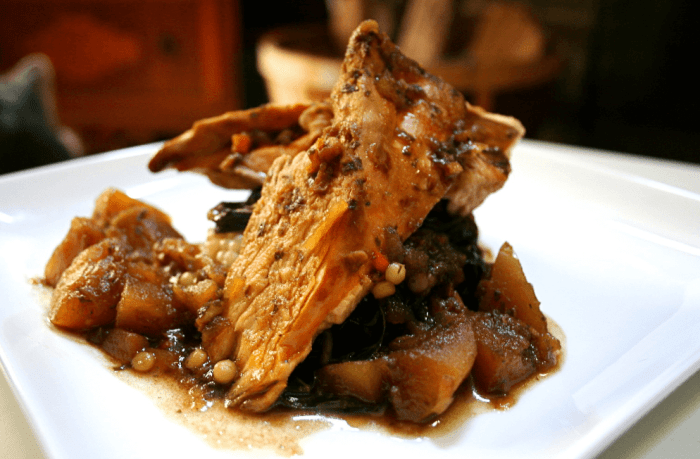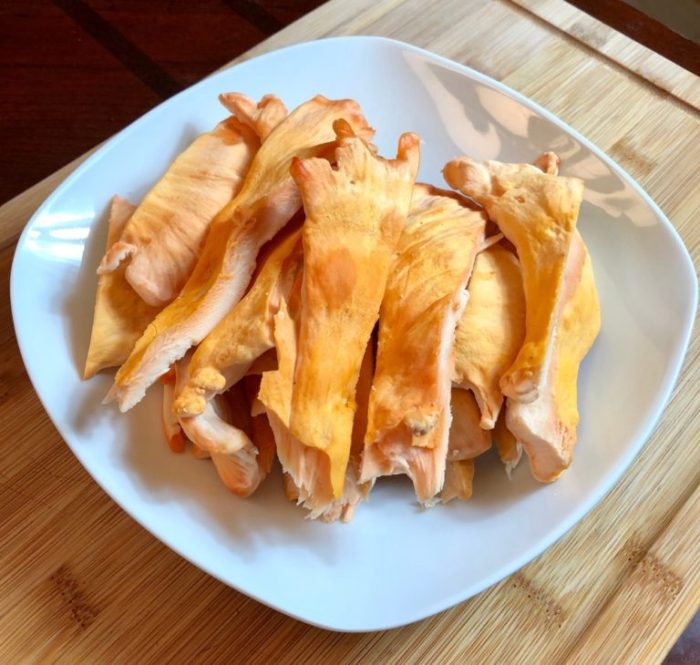
Prepare to embark on a culinary adventure with chicken of the woods recipe, an extraordinary edible mushroom that tantalizes taste buds while offering an array of health benefits. From its vibrant colors to its versatility in the kitchen, this wild delicacy is sure to captivate your senses and nourish your well-being.
As we delve into the world of chicken of the woods, we’ll explore its nutritional composition, uncover its medicinal properties, and provide a collection of mouthwatering recipes that showcase its culinary prowess. Get ready to discover the secrets of this hidden gem, from foraging techniques to cultural significance.
Chicken of the Woods Nutritional Benefits and Health Implications: Chicken Of The Woods Recipe

Chicken of the woods mushrooms are a nutritional powerhouse, boasting an impressive array of vitamins, minerals, and antioxidants. They are particularly rich in:
- Vitamin D: Essential for bone health and immune function.
- Potassium: Supports heart health and regulates blood pressure.
- Fiber: Promotes digestive health and satiety.
- Antioxidants: Protect against oxidative stress and inflammation.
Health Benefits
Consuming chicken of the woods mushrooms has been linked to several potential health benefits, including:
- Immune system support: Rich in antioxidants and polysaccharides, which boost immune function.
- Anti-cancer properties: Certain compounds in the mushrooms have shown promise in inhibiting cancer cell growth.
- Cardiovascular health: Potassium content supports heart health by regulating blood pressure.
- Anti-inflammatory effects: Antioxidants help reduce inflammation throughout the body.
Risks and Precautions, Chicken of the woods recipe
While chicken of the woods mushrooms are generally safe to consume, there are some precautions to consider:
- Raw consumption: Consuming raw mushrooms can cause digestive upset in some individuals.
- Allergic reactions: Some people may experience allergic reactions, such as skin rashes or difficulty breathing.
- Interactions with medications: Certain compounds in the mushrooms may interact with blood thinners and other medications.
Culinary Applications and Versatile Recipe Ideas

Chicken of the woods, with its unique flavor and texture, lends itself to a wide range of culinary applications. Whether you’re a seasoned chef or a home cook looking to experiment with new flavors, this versatile mushroom offers endless possibilities.
From hearty soups and stews to savory stir-fries and mouthwatering pasta dishes, chicken of the woods can elevate any meal. Its meaty texture makes it an excellent substitute for chicken or beef in many recipes.
Selecting and Preparing Chicken of the Woods
When selecting chicken of the woods, look for firm, bright-colored mushrooms. Avoid any with signs of bruising or decay. To prepare the mushrooms, gently brush off any dirt or debris and trim the tough base of the stems.
Flavor Profiles and Sensory Characteristics

Chicken of the woods mushrooms boast a distinct flavor profile that sets them apart from other edible mushrooms. They exhibit a complex blend of savory, umami-rich flavors, often described as reminiscent of chicken or seafood.
Aroma
Upon cooking, chicken of the woods mushrooms release an enticing aroma that fills the air. Their fragrance is earthy and slightly spicy, with hints of anise or licorice. The aroma alone is enough to whet the appetite and create a sense of anticipation for the culinary experience that awaits.
Taste
The taste of chicken of the woods mushrooms is equally captivating. They possess a meaty, umami-packed flavor that lingers on the palate. The mushrooms have a slightly sweet undertone, balanced by a subtle bitterness that adds depth and complexity to their overall taste.
Texture
Chicken of the woods mushrooms have a firm, yet tender texture when cooked. Their flesh is slightly chewy, providing a satisfying bite. When sautéed or grilled, they develop a crispy exterior that contrasts beautifully with their soft and juicy interior.
Comparison to Other Edible Mushrooms
Compared to other edible mushrooms, chicken of the woods mushrooms stand out for their unique flavor profile. Their savory, umami-rich taste is reminiscent of chicken or seafood, making them a versatile ingredient that can be used in a variety of culinary preparations.
Chicken of the woods is a delicious and versatile mushroom that can be used in a variety of dishes. Whether you’re looking for a simple sauté or a more complex recipe, there’s sure to be a chicken of the woods recipe that’s perfect for you.
While some mushrooms, such as shiitake or oyster mushrooms, have a more subtle flavor, chicken of the woods mushrooms offer a bold and assertive taste that makes them a standout ingredient in any dish.
Foraging Techniques and Sustainable Harvesting Practices
Chicken of the woods mushrooms are found in various environments, including deciduous forests, woodlands, and parks. Identifying them can be challenging due to their variations in appearance. However, there are key characteristics to look for:
- Color:Typically bright orange to yellow, with variations in shades.
- Shape:Irregular and shelf-like, with overlapping layers.
- Texture:Firm and slightly rubbery when fresh.
- Habitat:Growing on dead or decaying hardwood trees.
- Season:Summer to fall.
Ethical and Sustainable Harvesting
To ensure the preservation of chicken of the woods mushrooms, it’s crucial to follow ethical and sustainable harvesting practices:
- Leave some behind:Only harvest a portion of the mushroom cluster, leaving the rest for continued growth and spore production.
- Avoid damaging trees:Carefully remove the mushrooms without harming the tree they’re growing on.
- Respect other foragers:Avoid overharvesting and leave some for others to enjoy.
Proper Handling and Storage
To maintain the freshness and quality of chicken of the woods mushrooms, proper handling and storage are essential:
- Clean gently:Use a damp cloth or brush to remove any debris.
- Store in a paper bag:Keep the mushrooms in a breathable paper bag in the refrigerator.
- Use within a few days:Chicken of the woods mushrooms have a short shelf life, so consume them promptly.
Cultural Significance and Traditional Uses

Chicken of the woods mushrooms have played a significant role in various cultures throughout history, both as a food source and for their perceived medicinal properties.
If you’re looking for a more adventurous recipe, try making a chicken of the woods recipe that incorporates other ingredients, such as vegetables or cheese. Chicken of the woods is a great way to add flavor and nutrients to your favorite dishes.
Traditional Medicinal Uses
- In traditional Chinese medicine, chicken of the woods has been used for centuries to treat a variety of ailments, including liver and kidney problems, digestive issues, and respiratory infections.
- In some Native American cultures, the mushroom was believed to have antibacterial and antifungal properties and was used to treat wounds and skin infections.
Folklore and Beliefs
- In some parts of Europe, chicken of the woods was known as the “mushroom of the dead” and was associated with witchcraft and the supernatural.
- In contrast, in other cultures, the mushroom was seen as a symbol of good luck and prosperity and was often used in rituals and ceremonies.
Final Conclusion

Our exploration of chicken of the woods has revealed a treasure trove of flavors, health benefits, and cultural connections. Whether you’re a seasoned forager or a curious home cook, this extraordinary mushroom offers something for everyone. So, gather your ingredients, embrace the adventure of foraging, and prepare to savor the delights of chicken of the woods.
FAQ
What are the nutritional benefits of chicken of the woods?
Chicken of the woods is a nutritional powerhouse, rich in protein, fiber, and antioxidants. It’s also a good source of vitamins B and C, potassium, and zinc.
Can chicken of the woods be poisonous?
No, chicken of the woods is not poisonous. However, it’s important to note that some people may experience allergic reactions to mushrooms, so it’s always best to consume them in moderation.
How do I identify chicken of the woods?
Chicken of the woods is typically found at the base of oak trees. It has a bright orange color and a spongy texture. When in doubt, it’s best to consult with an experienced mushroom forager.





